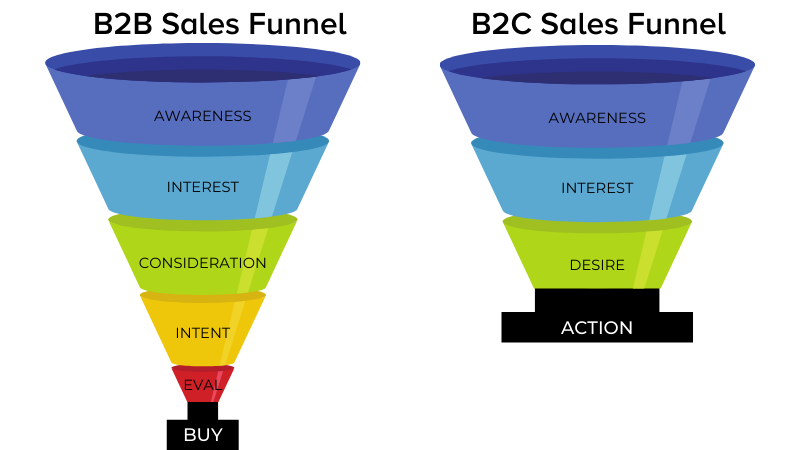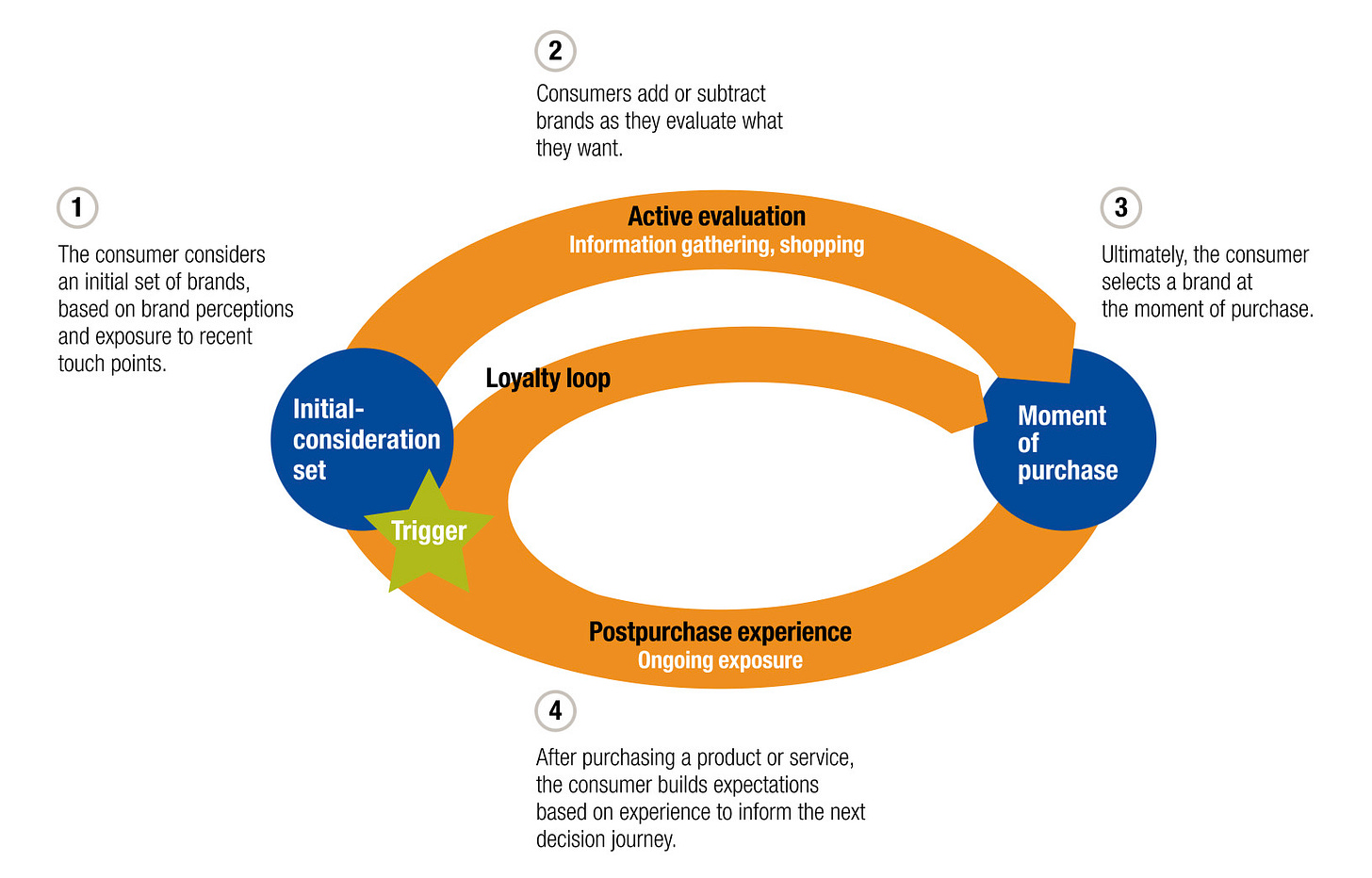Week 2! You ready?
The funnel. The infamous funnel. Pretty foundational thing if you’re writing a newsletter about marketing. I'll dive into marketing funnels, break them down, tie content types to each stage, and provide some more modern alternatives.
What is a marketing funnel?
A marketing funnel is a map that lays out each stage of the buyer’s journey. Your funnel should be a few things:
Contextual to your business - Your funnel stage names may be the same as many common models, but what they actually mean - aware, interested, considering, etc. - will be different for every business.
Adaptable - As the business grows, you’ll need to respond to a ton of things: buyer behaviors, emerging channels, market dynamics, and more. Tweaks to how your marketing team operates will impact your map of the customer’s journey (aka funnel) in some way. The larger, more structural aspects of the marketing funnel, however, are probably not things that should change month to month.
Scalable - The funnel (or alternate structure) is a foundational concept to your marketing function and changing it a lot will create confusion, inconsistency, and growth roadblocks. The best way to ensure this scales is to test early and often and be in close alignment with sales. Nothing will ever be perfect but clearly understanding each other's goals and running shared experiments is a surefire way to win.
Marketing Funnel Stages
Alright let’s break down the B2B funnel.
Marketing Funnel Stage Definitions
Keep in mind, each funnel stage can look different depending on who you are targeting. A few examples of buyer roles you could be targeting include:
Decision maker - often the most important one for most marketing and sales teams
Blocker - usually finance or legal haha jk sort of
Champion - loves your product and/or company and can be promoted as an advocate for your company
End user - the person who will ultimately be using your product. Sometimes the end user and decision maker are the same person depending on your product. Or any combination of roles! I’ll tackle buyer personas in a later edition.
There are many ways in which businesses approach their marketing funnels. A couple tried and true ones are:
AIDA - Awareness, Interest, Desire, Action. This also work very well in B2C as noted in the image above. Super simple and covers the core stages of any customer journey.
TOFU/MOFU/BOFU - saying these out loud around other humans can sound pretty cringe (you’ve been warned). But this is a wonderful way to simplify your funnel efforts regardless of what model you use.
Top of funnel
Middle of funnel
Bottom of funnel
Let’s break down the B2B funnel visualized above:
Awareness - The potential customer (or prospect) is aware of their problem and identifies possible solutions
Interest - The prospect shows interest in a group of solutions they believe address their problems
Consideration - The prospect is willing to move forward with a solution and is now comparing their options
Intent - The prospect is ready to purchase a solution and has likely not yet landed on a final option
Evaluation - The prospect is assessing if the specific solution they are considering is right for them, their team, and their goals
Buy - The prospect buys all the things!
In my experience, this is the extent to which a b2b marketing funnel is broken down. Anything more than 8 stages may be complicating things a little too much for your marketing and sales teams. Also, intent and evaluation could probably be consolidated. If your business relies on repeat customers (as most do) then adding a Loyalty or Advocacy stage after Buy is also valuable.
Content types by funnel stage
Some interesting stats:
The average customer engages with 3-5 pieces of content before talking to sales
87% of shoppers begin their search on digital channels (so having the right content is key to gaining their attention)
Now that we have the definitions for each stage of our funnel, let’s create a quick content map. Each type of content should be tied to a specific stage in the funnel. This ensures your marketing is timely and contextual to the buyer as they explore solutions. I’ll use the T/B/MOFU model for brevity:
TOFU (ie: Aware, Interest) - In this area, you want to provide avenues for prospects to discover your company.
Blog posts
Thought leadership-focused videos
Podcasts
(Most) social media updates
MOFU (Consider, Intent/Evaluate) - Now that your prospect is aware of your company, you need to build credibility and trust that your solution can solve their problem.
eBooks/Whitepapers
Webinars
Free quizzes/assessments
Case studies
Templates/toolkits
BOFU (Intent, Buy) - Your prospect is ready to buy and they are likely considering you and one or two other vendors. Your job is to convince them that you, and only you, will work for them.
Testimonials/customer stories
Competitor comparisons
Detailed solution specifications
Live demos
Free trials/discounts
As you can see, there is a ton of opportunity to build out content that is relevant to your prospective buyer in each stage of their journey. The challenge then becomes prioritizing based on team goals, availability, and ability to best deliver the content in a timely manner.
Alternate approaches to the traditional funnel
In 1898, Elias St. Elmo Lewis (what a name…) developed what was called the Purchase Funnel. It was based on the idea that for a sale to occur, every consumer must take the same steps toward a purchase. No matter what the product; no matter who the person is, the journey is the same.
This revolutionized how businesses sell to people and helped establish what we see today as marketing and advertising. However, as the world progressed, so did the way people searched for and bought products. This means that most buyer journeys are not linear. They may bounce in between awareness, interested, and considering for a while before coming to a decision. How many times have you actually seen an ad for a company you’ve never heard of and bought something right then and there? Exactly.
As a result, many companies and consulting firms have mapped out new models that supposedly speak better to modern buying behavior. I’ll talk about just a couple for now: The Consumer Decision Journey and the Flywheel.
The Consumer Decision Journey
Created by McKinsey, the Consumer Decision Journey maps out a circular journey with four phases: initial consideration; active evaluation, or the process of researching potential purchases; closure, when consumers buy brands; and postpurchase, when consumers experience them
Personally, I think this is an alright model. Much of it makes sense and none of it is inherently wrong. It over-assumes the awareness stage a bit, at least in its explanation of the Initial Consideration Set. It also does not assume that the prospect is aware of the problem they are trying to solve but I noticed in my research that most models don’t factor this. So a good real world marketing tip for you: your potential customer may not even know they have the problem you are trying to solve. This model is likely very helpful for consumer-facing brands.
The Flywheel Model
I first learned about the flywheel model from a company called HubSpot (I’ll probably be talking about them frequently in this newsletter as I’m a big fan). They adapted the flywheel model as a new approach to modern marketing and sales behavior.
From their site:
“The Flywheel is a model adapted by HubSpot to explain the momentum you gain when you align your entire organization around delivering a remarkable customer experience. It is remarkable at storing and releasing energy — and it turns out that’s pretty important when thinking about your business strategy. Invented by James Watt, the flywheel is simply a wheel that’s incredibly energy-efficient. The amount of energy it stores depends on how fast it spins, the amount of friction it encounters, and its size. Think of it like the wheels on a train or a car.
This energy is especially helpful when thinking about how customers can help your business grow.
Other models think of customers as an outcome — nothing more, nothing less. All of the energy you spent acquiring that customer is wasted, leaving you at square one.“
The flywheel essentially puts growth at the center and does not inherently consider the stage at which the buyer is at. As mentioned above, it’s all about the customer experience which is often not linear (as the traditional funnel assumes).
This is a significant philosophical shift around marketing and sales which can also be applied to general business practices. Here’s an awesome visual that lays out Amazon’s flywheel approach to their business. Again, it puts growth at the center with numerous business dynamics that work within each other.
All of these models essentially get at the same thing: mapping out the stages that lead to a customer buying from you. You will primarily work within the traditional funnel throughout your career and that is totally fine. Every business is different and whatever model you work with can be successful as long as there is significant thought put behind the content and customer experience.
I have primarily used the traditional marketing funnel in my career as it’s most understood by members of leadership and sales. That being said, I have made a strong effort to communicate the philosophy of the flywheel to teams I work with. You can marry tried-and-true models as well as modern funnel alternatives and I did that at Brightfield Group:
Use the traditional funnel to map out content strategy and processes in collaboration with sales - easier to communicate owners, develop strategies, plan projects, and identify most important activities.
Use the flywheel model with my marketing team as a team philosophy to follow - helped develop a growth mindset focused on key metrics and a stronger emphasis on the customer experience.
At the end of the day, funnels are a framework and frameworks can be debated until the end of time. Do whatever moves the needle for your team.
That's all I got for now. See ya next week!
-Connor
Additional Resources on Marketing Funnels
The Flywheel Model (HubSpot)
Good question + thread from Chelsea Castle (ChiliPiper)









